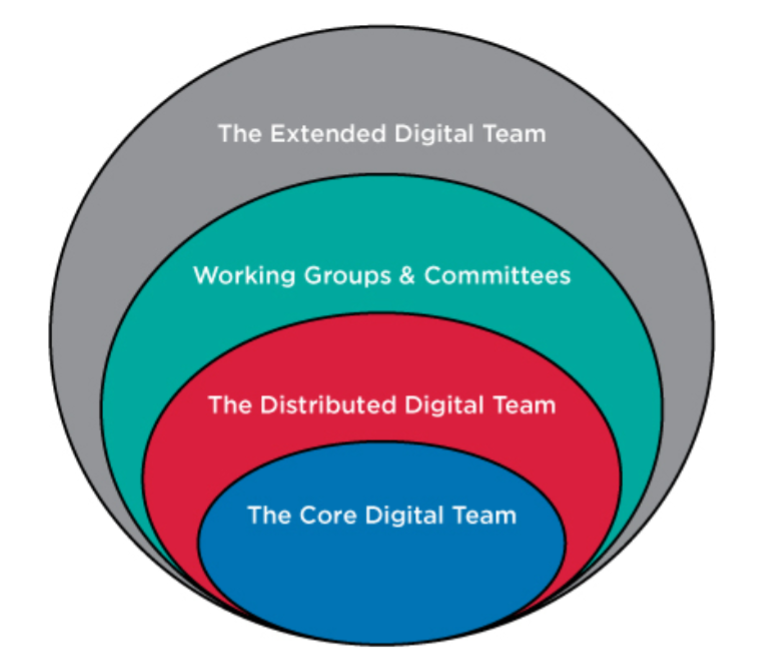At the core of effective digital governance models sit four digital teams with a clear division of responsibilities. In chapter two of her book, Lisa Welchman explains her rationale for designing the four-team model and why it works.
The Four Digital Teams
In her decades-long practice, Lisa Welchman developed a digital team classification model that does away with departmental silos and focuses on competencies that are essential to creating policies and standards. According to her model, every person who touches content will belong to one of the four teams: the core team, the distributed team, working groups and committees, and the extended team.

The core digital team oversees the organisation’s entire digital presence. Welchman splits the core team into two functions: program management and product management. Program management is the administrative side of digital, focused on enabling the digital process and ensuring that the team has the necessary resources. Product management is a label given to all administrative responsibilities of the core team that ensures the organisation’s digital system functionality. This team will also inform digital policy and define digital standards with input from the other teams.
As stated earlier, the job titles of the members of the team are not relevant - it’s the leadership and project management expertise that matters the most when composing the core team. However, Welchman warns against splitting the core team across different departments, stating that it should be kept whole to ensure close collaboration. Ideally, the core team should be able to actively communicate and address the governance topics regularly, particularly in the early stages of the project.
The distributed digital team is responsible for maintaining a particular aspect of the digital presence, such as content, applications, or data. Its scope is narrower because the distributed team’s strength is its subject matter expertise and the authority to provide direction for the definition of standards that are relevant to its area of work.
Committees, councils, and working groups are formed to address specific digital concerns. They can be permanent or temporary and are particularly useful for generating ideas and making recommendations. This type of digital team has the power to facilitate collaboration and engagement as committees can be formed ad hoc across departments to collect insights. However, Welchman cautions against falling into the trap of delegating the task of governance to these groups. There should always be an overseeing core team in place that controls how the governance framework impacts the entire content operations rather than a very specific digital area.
The extended digital team includes external support, such as agencies of record, software integrators, and other vendor support. Lisa Welchman, a management consultant with a keen eye for resource allocation and operational efficiency, advises incorporating all independent vendors and contractors into the team and noting their contributions in terms of workload versus cost. In her own words, external teams will not voluntarily assess their usefulness to your operations and it could be that you recognize opportunities for cutting costs and streamlining the governance process by moving it completely in-house, where you have more oversight.
Conclusion #
Lisa Welchman (2015, p.33) wrote that “the main product of digital team disorganisation is redundancy of effort, which can lead to a poor user experience or fiscal waste.” In content strategy, where quality relies on creating repeatable processes easily implemented by both large and small content teams, the four-team model can be particularly useful. It helps with a structured and directional approach to editorial planning and removes risks of conflict and project stoppage due to unclear responsibilities. Governance, according to Welchman brings back the focus from mass content production to purposeful content creation that supports business strategy and customer needs.
You can find more articles about governance written by Lisa Welchman on her website: https://www.lisawelchman.com/.
Where to go from here #
References #
Welchman, L. (2015). Managing Chaos: Digital Governance by Design. Rosenfeld Media.
Welchman, L. (2023, January 12). Lisa Welchman’s Official Website. Lisa Welchman. https://www.lisawelchman.com/

